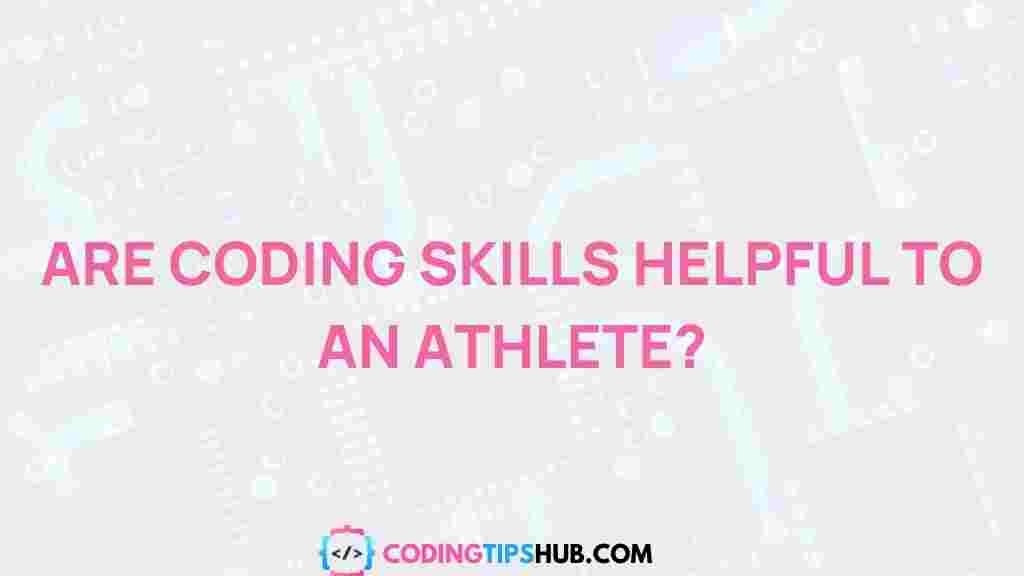Coding Skills: Unleashing the Hidden Power of Coding for Athletes
In today’s rapidly evolving world, athletes are increasingly turning to technology to enhance their performance, optimize training routines, and even prevent injuries. One of the most powerful tools at their disposal is coding. While coding might traditionally be associated with computer science or software development, it’s quickly becoming a game-changer for athletes who want to take their performance to the next level. This article will explore how athletes can unlock the hidden power of coding skills to enhance their training, improve recovery, and ultimately achieve their goals.
Why Athletes Need Coding Skills
Coding offers athletes the ability to interact with data in a way that can provide deep insights into their performance. By learning how to analyze and manipulate data, athletes can make more informed decisions about their training, diet, and recovery strategies. In addition, coding skills open doors to creating custom tools and apps tailored to an athlete’s specific needs, helping them to track everything from workout progress to sleep patterns.
How Coding Can Benefit Athletes
The integration of coding into athletic training offers several key benefits:
- Data Analysis: Coding allows athletes to analyze performance data in real-time, identifying trends and areas for improvement.
- Personalized Training: Custom programs can be built to track and optimize individual performance metrics.
- Injury Prevention: By analyzing movement patterns and biomechanics, athletes can proactively address potential injury risks.
- Enhanced Recovery: Coding can help develop recovery tools that monitor rest and suggest strategies for optimal recovery times.
Step-by-Step Guide to Building Coding Skills for Athletes
If you’re an athlete eager to unlock the power of coding, follow these steps to get started:
1. Start with the Basics
Before diving into complex coding languages, it’s essential to understand the fundamentals of programming. Begin with languages that are user-friendly for beginners, such as Python or JavaScript. These languages are versatile, easy to learn, and widely used in data analysis and app development.
2. Learn Data Analysis Techniques
Data is central to performance improvement, so learning how to analyze it effectively is crucial. Athletes can focus on learning libraries like Pandas (for Python) and NumPy for numerical data processing. These tools will allow you to work with large datasets, uncover patterns, and generate actionable insights.
3. Explore Sports Science Tools
Many sports science tools and applications, such as Strava or Garmin Connect, allow athletes to track performance data. By learning how to integrate these tools with custom-built software, athletes can create a more comprehensive picture of their training progress and recovery. Try learning how to work with APIs (Application Programming Interfaces) from fitness platforms to pull your data into your own analysis systems.
4. Build Custom Tools for Performance Tracking
As you become more comfortable with coding, start building your own tools. This could include simple apps or scripts that track training logs, monitor heart rate variability, or even provide recovery tips based on your activity levels. With coding skills, you’re no longer limited by generic platforms and can tailor your tools to your unique needs.
5. Join Online Communities
The world of coding can be overwhelming at first, but joining online communities can provide invaluable support. Websites like Stack Overflow and GitHub are excellent places to find solutions to coding challenges, collaborate on projects, and learn from others in the tech and sports communities.
Real-World Applications of Coding for Athletes
Now that you understand the basics, let’s delve into some specific ways coding skills can directly benefit athletes in various sports.
1. Monitoring Movement and Biomechanics
Coding can be used to create tools that analyze an athlete’s movement in real-time. Using motion-capture technology, athletes can track biomechanical data and adjust their form to improve efficiency or reduce the risk of injury. This could be particularly useful for sports like running, swimming, or weightlifting.
2. Analyzing Training Load and Fatigue
By collecting data on training load, heart rate, and perceived exertion, athletes can use coding to predict when they might be overtraining or at risk of burnout. Coding allows you to combine these data points into a model that provides real-time feedback on your recovery status, helping you optimize your training schedule.
3. Creating Personalized Nutrition Plans
Nutrition is a critical aspect of athletic performance. By using coding to track dietary intake and combine it with performance data, athletes can develop personalized meal plans that optimize energy levels, improve recovery, and support muscle growth. This can be achieved through apps that allow athletes to input their meals and automatically suggest nutritional adjustments based on their goals.
Troubleshooting Common Coding Challenges for Athletes
While the benefits of coding are clear, athletes may face some challenges when learning to code. Here are a few common issues and troubleshooting tips:
- Challenge: Difficulty understanding programming concepts.
- Solution: Start with small, manageable projects and build on your knowledge incrementally. Use online tutorials and courses to guide your learning process.
- Challenge: Managing large datasets.
- Solution: Break the data into smaller chunks and use data-cleaning techniques to simplify your analysis.
- Challenge: Integrating third-party tools.
- Solution: Research the APIs provided by fitness tracking platforms and use libraries like Requests in Python to interface with these systems.
Conclusion: The Ultimate Power of Coding for Athletes
As we’ve seen, coding skills can be a powerful tool in an athlete’s arsenal, offering new ways to analyze performance, prevent injuries, and personalize training programs. By investing time in learning coding, athletes can unlock a wealth of possibilities, from customized fitness apps to advanced data analysis techniques. Whether you’re an aspiring professional or an amateur looking to take your performance to the next level, the ultimate benefits of coding are clear. Start learning today and experience the hidden power of coding for athletes!
This article is in the category News and created by CodingTips Team
